Scollon, R. (2005). “The Discourse of food in the world system
advertisement
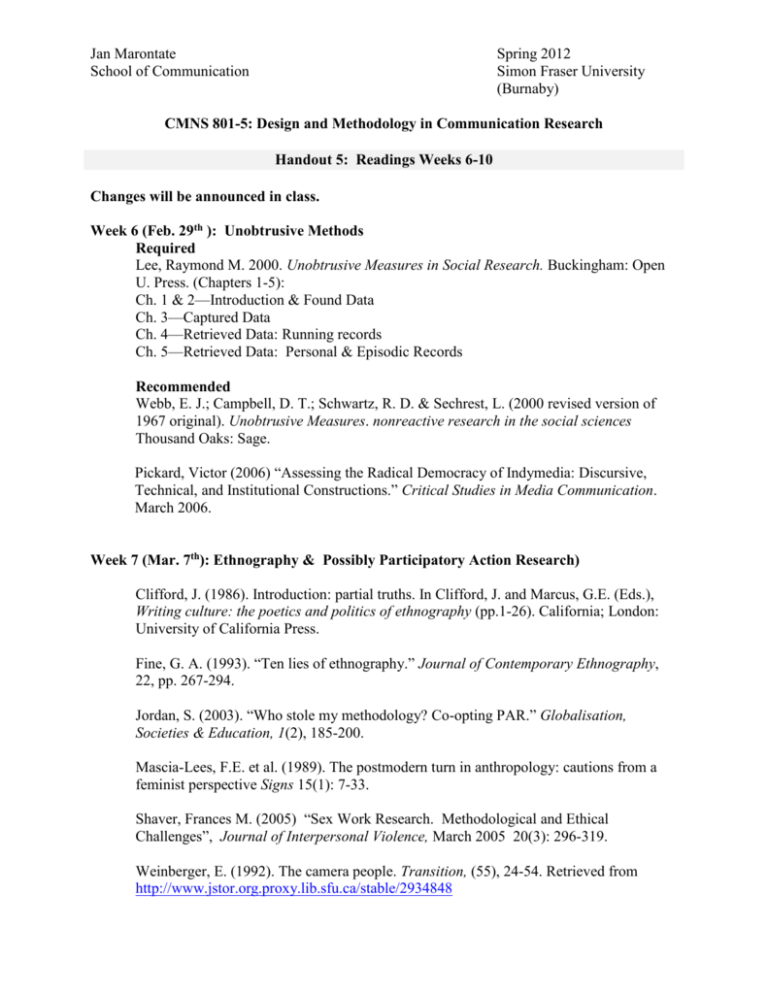
Jan Marontate School of Communication Spring 2012 Simon Fraser University (Burnaby) CMNS 801-5: Design and Methodology in Communication Research Handout 5: Readings Weeks 6-10 Changes will be announced in class. Week 6 (Feb. 29th ): Unobtrusive Methods Required Lee, Raymond M. 2000. Unobtrusive Measures in Social Research. Buckingham: Open U. Press. (Chapters 1-5): Ch. 1 & 2—Introduction & Found Data Ch. 3—Captured Data Ch. 4—Retrieved Data: Running records Ch. 5—Retrieved Data: Personal & Episodic Records Recommended Webb, E. J.; Campbell, D. T.; Schwartz, R. D. & Sechrest, L. (2000 revised version of 1967 original). Unobtrusive Measures. nonreactive research in the social sciences Thousand Oaks: Sage. Pickard, Victor (2006) “Assessing the Radical Democracy of Indymedia: Discursive, Technical, and Institutional Constructions.” Critical Studies in Media Communication. March 2006. Week 7 (Mar. 7th): Ethnography & Possibly Participatory Action Research) Clifford, J. (1986). Introduction: partial truths. In Clifford, J. and Marcus, G.E. (Eds.), Writing culture: the poetics and politics of ethnography (pp.1-26). California; London: University of California Press. Fine, G. A. (1993). “Ten lies of ethnography.” Journal of Contemporary Ethnography, 22, pp. 267-294. Jordan, S. (2003). “Who stole my methodology? Co-opting PAR.” Globalisation, Societies & Education, 1(2), 185-200. Mascia-Lees, F.E. et al. (1989). The postmodern turn in anthropology: cautions from a feminist perspective Signs 15(1): 7-33. Shaver, Frances M. (2005) “Sex Work Research. Methodological and Ethical Challenges”, Journal of Interpersonal Violence, March 2005 20(3): 296-319. Weinberger, E. (1992). The camera people. Transition, (55), 24-54. Retrieved from http://www.jstor.org.proxy.lib.sfu.ca/stable/2934848 2 Recommended: Bird, S. E. (1992) ” Travels in Nowhere Land. Ethnography and the ‘Impossible’ Audience”. Critical Studies in Mass Communication 9: 250-260. Clifford, J. (1986). Introduction: partial truths. In Clifford, J. and Marcus, G.E. (Eds.), Writing culture: the poetics and politics of ethnography (pp.1-26). California; London: University of California Press. Garfinkel, H. (1967). Studies in Ethnomethodology. Cambridge, UK: Polity. Koester, Stephen (1995) “Applying the Methodology of Participant Observation to the Study of Injection-Related HIV Risks” in Qualitative Methods in Drug Abuse and HIV Research National Institute on Drug Abuse Monograph Series 157, pp. 84-99. (Electronic document title begins with HIV in the Readings folder). Lofland, J. and Lofland, L (1995) Analyzing social Settings. A Guide to Qualitative Observation and Analysis. Washington: Wadsworth. Spradley, James The Ethnographic Interview (1979) Holt, Rinehart and Winston. Weinberger, E. (1992). The camera people. Transition, (55), 24-54. Retrieved from http://www.jstor.org.proxy.lib.sfu.ca/stable/2934848 Week 8 (Mar.14th): Textual Analysis (Critical Discourse Analysis, Content Analysis) Chiapello, E., & Fairclough, N. L. (2002). “Understanding the new management ideology: A transdisciplinary contribution from critical discourse analysis and new sociology of capitalism.” Discourse & Society, 13(2), 185. Fairclough, N. (2002). “Critical Discourse Analyss as a method in social scientific research” in Wodak, R. and M. eyer (ed) Methods of Critical discourse Analysis, London: Sage, pp. 129-138. Philo, Greg. (2007). Can discourse analysis successfully explain the content of media and journalistic practice?. Journalistic Studies, 8(2), 175-196. Scollon, R. (2005). “The Discourse of food in the world system: Toward a nexus analysis of a world problem.” Journal of Language and Politics 7(4), 465-488. Recommended Fairclough, N. (2005). "Critical Discourse Analysis in Transdisciplinary Research" A New Agenda in (Critical) Discourse Analysis. Eds. Wodak R. & Chilton P. Amsterdam: John Benjamins Publishing Company. (pp. 53-70) Slembrouck, S. (2001). “Explanation, interpretation and critique in the analysis of discourse.” Critique of Anthropology, 21(1), 33. Week 9 (March 21s): Visual Methods Bal, M. (2003). “Visual Essentialism and the Object of Visual Culture.” Journal of Visual Culture Vol. 2(5):9-32. 3 Available online at: http://vcu.sagepub.com/cgi/content/abstract/2/1/5 Jewitt, C. and R. Oyama. (2001) “Visual Meaning: a Social semiotic Approach” in Van Leeuwen, T., and Jewitt, C. Eds. Handbook of Visual Analysis, Sage Publications.pp. 134-156. Lister, M., and Wells, L. (2006). “Seeing Beyond Belief: Cultural Studies an Approach to Analyzing the Visual”. Van Leeuwen, T., and Jewitt, C. Eds. Handbook of Visual Analysis, Sage Publications. 61-91. Van Leeuven, T “Semiotics and Iconography” in Van Leeuwen, T., and Jewitt, C. Eds. Handbook of Visual Analysis, Sage Publications. Pp. 91-118. Recommended Bal and others (2003) Responses to Mieke Bal’s “Visual Essentialism and the object of visual culture”, Journal of visual culture 2(2): 260-268. Bal, Mieke. (2002) “Chapter 1: Concept” in Traveling Concepts in the Humanities: A Rough Guide, 22-55. Toronto: University of Toronto Press. Hatfield, K. L.; Hinck, A.; Birkholt, M. J. (2007). “Seeing the Visual in Argumentation: A Rhetorical Analysis of UNICEF Belgium's Smurf Public Service Announcement” Argumentation and Advocacy Vol. 43. 144-151. Hirsch, M. (1997). Introduction. In M. Hirsch, Family frames: Photography, narrative, and postmemory (pp. 1-15). Cambridge, MA: Harvard University Press. Mirzoeff, N. (202) The Visual Culture Reader. London & New York: Routledge. Tufte, Edward. (2001) The visual display of quantitative Information, 2nd edition Tufte, Edward (1997) Visual Explanations. Images and Quantities, Evidence and Narrative Tufte, Edward R. (1997) Visual and Statistical Thinking: Displays of Evidence for Making Decisions. Cheshire , Conn: Graphics Press.31 pp. Ware, C. (2004) Information Visualization: Perception for Design.San Francisco: Morgan Kaufmann. Van Leeuven, T and Carey Jewitt (2001) “Introduction” in Van Leeuwen, T., and Jewitt, C. Eds. Handbook of Visual Analysis, Sage Publications pp. 1-9. Visual Culture Questionnaire (1996), October, 77(summer), 25-70. Week 10: (March 28th): Virtual Methods Beaulieu, Anne. (2004). Mediating Ethnography: Objectivity and the Making of Ethnographies of the Internet. Social Epistemology 18(2-3): 139-163. 4 Brugger, N. (2009). Website History and the website as an object of study. New Media & Society , 11 (1&2), 115-132. Clark, D. (2004). What If You Meet Face to Face? A Case Study in Virtual/Material Research Ethics. In E. Buchanan (Ed.), Readings in Virtual Research Ethics: Issues and Controversies (pp.246-261). Wisconsin: Information Science Publishing. Farrell, Dan; Petersen, James C. (2010) The Growth of Internet Research Methods and the Reluctant Sociologist. Sociological Inquiry 80. 1 (Feb 2010): 114-125. Christine Hine (2005): Internet Research and the Sociology of Cyber-Social-Scientific Knowledge, The Information Society: An International Journal, 21:4, 239-248 Rosenzweig, R. (2005) “Can history be open source?” Journal of American History. June: 117-146. Recommended Hines, Christine (ed.) 2005. Virtual methods: issues in social research on the Internet. NYC: Berg. Bolter, J., D. (2003). “Critical Theory and the Challenge of New Media.” Eloquent Images: Word and Image in the Age of new Media. Hocks, M., and Kendrick, M., Eds. MIT Press. 19-36. Part 3: Term Project Presentations Weeks 11-12 (Apr. 4th & 11th) and possibly Week 13. (An additional class session may be added in the first week of exams if needed, depending on class size).
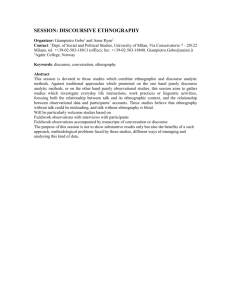


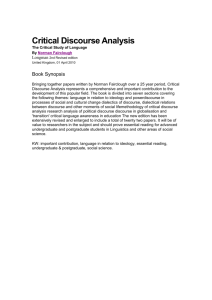
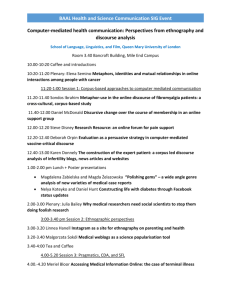
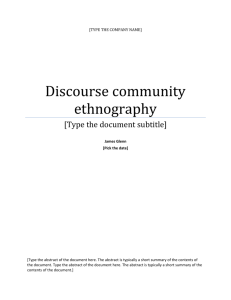

![Discourse of Social and Personal Identity [DOCX 12.10KB]](http://s3.studylib.net/store/data/006866911_1-bb7b609b10ed7b210db4baa051ed3847-300x300.png)
